
Traditional musical instruments of Nepal

Traditional musical instruments of Nepal
swotah travel
21186
08, 05 2023
Nepal, despite being a small landlocked country, is one of the richest places in the entire globe in terms of religion, ethnic groups, and languages. There are 126 castes, more than 50 ethnicities, and 120 plus languages, according to the 2011 census. This vividity in religion, castes, and language brings out the different traditional musical instruments. More than 200 musical instruments have their origin associated with Nepal.
Different communities play different instruments that have their own historical backgrounds and significance. These traditional musical instruments reflect the unity in diversity as music binds people together and decreases their differences. Marriage ceremonies, traditional practices, Jatras, festivals, etc., are incomplete without traditional folk melodies.
Some of the famous traditional musical instruments of Nepal that are played to this date widely and enjoyed that bring people together are:
-
Sarangi
Saranagi is made up of Khirro wood, is slightly bowed, has a hollow bottom, and has four strings tightly attached to it. This traditional musical instrument has a separate thin stick that is rubbed against those strings to produce a beautiful musical sound. Gandarva community used to play Sarangi during the old days but on today’s date everyone enjoys playing Sarangi be it Gandarva or not. The melody that comes from Saranngi makes you feel like you are in musical heaven. It could be compared to the violin for an easy understanding of how it produces its rhythm.
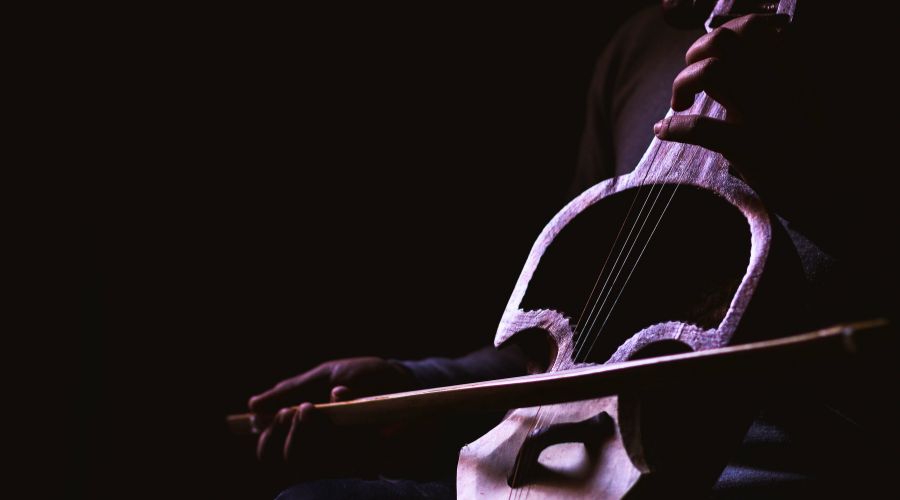
Photo: Sarangi
-
Madal
Madal has a cylindrical figure. Madal’s body is made from wood, and its head is made from Goat’s skin. The circular black surface on the other hand is made from flour paste which is black. It is hollow from the inside. Madal has thread/rope attached from either side’s end that can be put around your neck or waist. This lets you use your hands-free to play it. Madal could be taken as a drum that is played by striking your hands against the circular black surface present on either side.
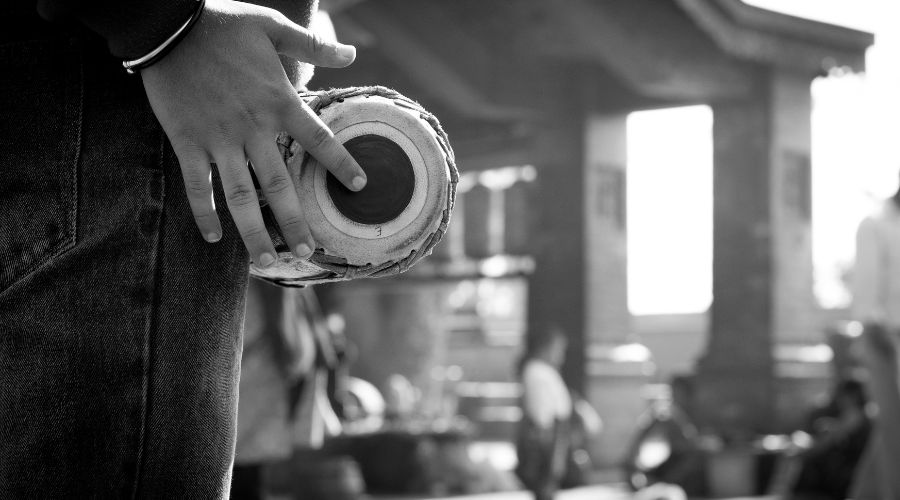
Photo: Madal
Although the Magar community first introduced Madal. Nowadays, everyone seems to indulge in playing it. People like to play Madal mostly during deusi and bhailo (a celebration where people go around houses in their community singing and dancing different folk songs and cultural dances during festivals called Tihar).
Nepalese people love to sing and dance their hearts out to the typical tune of Madal. It is a national musical instrument of Nepal.
-
Bansuri
Bansuri or Basuri is also known as Murali. This traditional musical instrument holds a special place in the hearts of the Hindu people because it was believed to be played by Krishna (the Hindu god ). Bansuri is made from a bamboo shaft. It looks like a long slender tube. Bansuri has 6 to 8 holes on its body, depending on its size. These holes are responsible for producing different-pitched melodies.
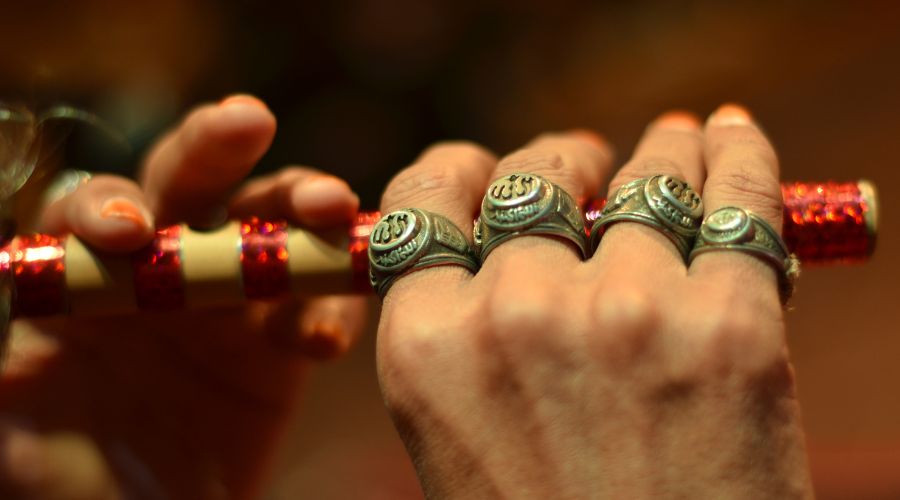
To play bansuri, you hold it horizontally, place your fingers on the holes and move it along as required ( like you adjust your fingers while playing guitar to produce different vibrations) as you blow it with your mouth at the same time. If you have not heard of Bansuri, then you are missing out massively. It is 100 % sure to take all your stress away.
-
Tungana
Tungana looks like Saragi to some extent. Tungana is also made up of wood and has four strings attached from head to bottom like sarangi. But unlike Sarangi, the Tungana has a hollow cavity coated with goat skin. Another difference between these two is the way they are played. As mentioned earlier, the sarangi has a special stick that is rubbed against it’s string to produce sound whereas Tunaga is played with hands. You move your fingers along it’s guitar ( somewhat similar to playing a guitar).

The Tamang community played this traditional instrument at their festivals and cultural activities. Needless to say, like every other musical instrument, Tunagana has also made a place in the hearts of other community’s people. If you want a Western musical instrument’s reference to understanding Tungana better, then it could be taken as a type of Trumpet.
-
Dholak
Dholak is basically a bigger version of Madal. It is made from wood and is hollow from the inside. It has two ends, one of them is bigger in size than the other. The smaller end is covered with Goat’s skin, whereas the larger end is covered with buffalo’s skin. You use your hands to play it. Strike your hands on either side of the Dholak preferably the smaller side for lower pitched rhythm and the bigger/ larger side for higher pitched rhythm.
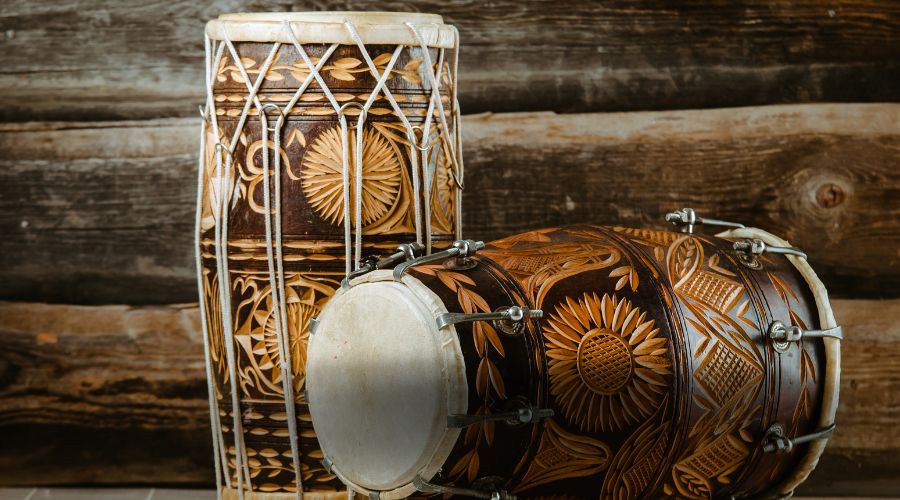
This traditional musical instrument is mainly played to celebrate welcoming newborns or harvest crops. Many people play it for the celebrations of the “festival of colours”, Holi.
-
Panche Baja
Panche Baja is a group of five musical instruments: Jhyamta (Jhurma ), Nagara (Damaha), Sahanai, Tyamko, and Narshingha. Panche Baja is played to begin auspicious occasions like marriage. Majorly panche baja is played in janti (at the wedding groom and his family go to the bride’s house dancing and singing the entire way). Starting any occasion by playing panche Baja is said to bring good luck.
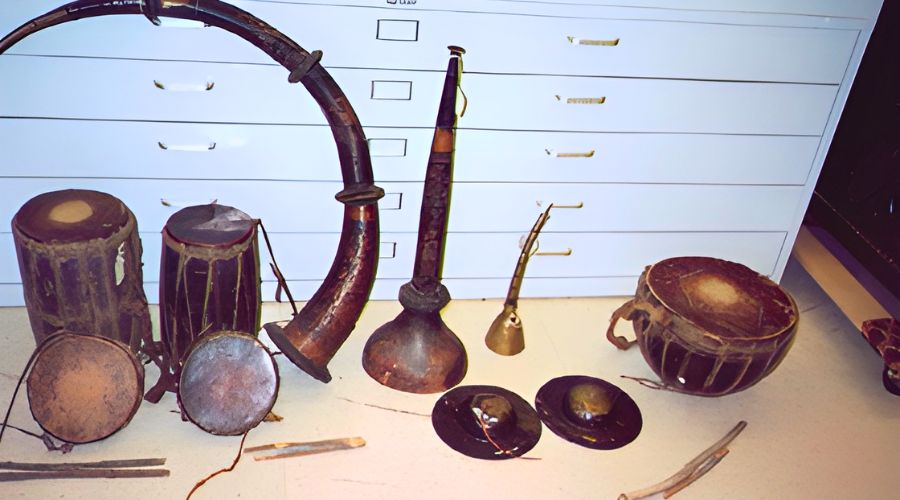
- Jhyamta (Jhurma )
This traditional musical instrument consists of a pair of circular disc-like objects. These circular discs of Jhyamta are made up of either brass or bronze. To play Jhyamta, its two discs are striked on one another.
Jhurma is generally played by Newari and Kirant communities during celebrations, festivals, and jatras (a type of street festival especially celebrated by the Newa community).
- Nagara (Damaha)
Nagara or Damaha could be taken as a bass drum. It is composed of leather, brass, and wood. It looks like a semi-circle with a flat circular surface, but the other end is a little more pointed than that of a semi-circle. Damaha is played with two sticks. To play Damaha these sticks are hit on its surface. Playing Nagara or Damaha, people celebrate the festival and dance along to its beat.
- Sahanai
Sahanai or Shenahi has a pipe-like structure. One end of it is quite narrow, while the other one is broader as it has a larger circumference. This Traditional musical instrument is made from wood or metal. Its body has 6 to 9 holes. To play Sahenai you blow into the narrower end of it, and the sound is produced from the broader flared end. It is played during auspicious occasions and is believed to take bad spirits away.
- Tyamko
Tyamko is a smaller version of Damaha. It is a kettle drum made from wood, clay, copper, and iron. Just like Damaha Tyamko has two drumsticks called gajo. To play this traditional musical instrument, you hit gajo on its surface. Tyamko is usually played for celebrations or at jatras. Newari people are seen dancing to the tune of Tyamko during their street festivals ( jatra ) like Indra jatra, bisket jatra, etc.
- Narshingha
Nar means buffalo and Singha means horn, so simply put the name means “ buffalo horn”. It is long and curved. It is hollow from the inside and has one narrow end and another broader end, somewhat similar to that of Sahanai. To play this musical instrument, one blows air from the narrow end. Narshingha is typically played during festivals and celebrations.
- Damaru
Damaru is a small drum. It has the shape of an hourglass. Damaru has two drumheads, which are made of leather. A thread is tied around it’s waist. Damaru is a traditional musical instrument whose roots go way back in time. It is believed to be played by lord Shiva. To play damaru one holds it by its waist and moves the hand sideways or rotates. In doing so, two ends of the thread hit two surfaces ( drumhead ) of the Damaru that produces the musical sound.
- Murchunga
Murchunga is believed to be one of the oldest musical instruments to originate from Nepal. It can be found to be made with different substances like brass, bronze, silver, copper, etc. Murchunga comes in different shapes and typically it is a handful in size. The most common shape of the Murchunga is similar to that of the lyre. Kirati and Mongolian people are known to play Murchunga since forever. Playing this traditional musical instrument requires special skills and lots of practice. To hear it being played really well, you will have to visit old Kiranti or Mongolian people.
Murchunga has a wire that is made with iron. To play it properly you hold it in your mouth, hold it between your teeth and play the string with your forefinger. Kirati or Mongolian people play Murchunga while performing their cultural/traditional rituals and some festivals.
Conclusion
There are many other traditional musical instruments that originated from Nepal, like Sankha, Dhimay, Kahinjadi, Ek Tare, Kangling, Yalamber baja, Dafali, Pungi, Tabla, etc. all these musical instruments have their own origin. Different communities of people based on caste, religion, and ethnicity have their traditional musical instruments that reflect their history with the unique significance of each.
NEWSLETTER SIGNUP
Sign up to receive our trip ideas and travel offers!
Get updates and Exclusive Offers up to 20% Discount








